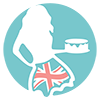0:00
With the right buttercream consistency you can achieve smooth frosting and neat piping on cakes
0:06
and cupcakes. The perfect buttercream consistency really is the key to cake decorating so here are
0:13
all of the do's and don'ts. You'll need a paddle or beater attachment to make buttercream, not a
0:19
whisk. A stand mixer or a hand mixer is fine or just a bowl and a spatula if you're very strong
0:26
and very patient. Okay here are my tips. Use room temperature butter so take it out of the fridge
0:32
at least two hours before you use it. If you forget you can unwrap the butter and microwave
0:37
it for 10 seconds, flip it over and microwave another 5 to 10 seconds until it's soft like this
0:44
Beat it for a few minutes until it's smooth. Starting with smooth butter can help prevent
0:49
lumps. Add icing sugar or powdered sugar, sifted to prevent lumps and graininess. If it feels like
0:56
it's taking forever to sift and your arm gets tired you can use the handle of a spatula or
1:01
wooden spoon to stir the sugar around in the sieve. I add half of the sugar at a time to the mixer so
1:07
it doesn't explode out of my mixer when I turn it on and I cover my bowl with a towel to prevent a
1:13
big cloud of sugary dust. Once the first half of the sugar is mixed in add the rest and mix again
1:20
Always mix at the lowest speed because using a low speed prevents air bubbles in the buttercream
1:26
If you use a whisk or a high speed you'll aerate the buttercream creating lots of air bubbles
1:33
Add salt and vanilla for flavour and now add a few tablespoons of milk or cream, one spoonful at a
1:40
time for richness and to thin the buttercream out slightly. Be careful with milk, too much will make
1:46
the buttercream too runny and to thicken it you'll need to add more sugar. This buttercream has a
1:52
stiff consistency which is great for piping that needs to hold its shape like petals on a rose for
1:58
example. Do you see how stiff these peaks are? To ice or frost a cake you need the buttercream to
2:04
have a looser consistency, less stiff, which means adding more milk until instead of stiff peaks the
2:11
peaks of the buttercream droop over like this. If you see any grains of sugar in your buttercream
2:17
or any tiny lumps you don't have to throw it all away and start again. Instead use an immersion
2:22
blender to blitz it to remove any icing sugar lumps. Any liquid you add to the buttercream will
2:29
affect the consistency so add any liquid colour or flavour and then stir the buttercream to knock
2:35
out any air bubbles. Now do a final consistency check and if the buttercream is still too stiff
2:41
or if there are any air bubbles in it use this microwave hack. Scoop a third of the buttercream
2:47
into a microwave safe bowl and microwave it for 10 seconds then pull this back into the main
2:53
bowl of frosting and stir it all together. Your buttercream will be silky smooth, the perfect
2:58
consistency for frosting a cake and with no air bubbles. So do use room temperature butter, don't
3:06
use lumpy sugar, sift it. Do mix the buttercream for several minutes until it's really smooth but
3:13
don't use a high speed, stick to the lowest. Do thin the buttercream out with milk or the microwave
3:19
hack or both but don't overdo it with too much milk or too long in the microwave. Do remove any
3:26
air bubbles by stirring the buttercream with a spatula or using the microwave hack or both. Tell
3:32
me in the comments if this has been useful and to learn hundreds of cake decorating techniques
3:36
and designs visit my cake school on britishgirlbakes.com. See you there


